The Mojave Desert is an unhospitable environment but wildlife still thrives here.
Rivers such as The Mojave River, The Amargosa River, and Deep Creek are all sustaining local wildlife.
Plants such as creosote bush, Joshua trees, yucca, and cacti also attract diverse and often numerous species.
From snakes to birds and fish to toads, many species live here all the time, and a few species migrate here outside of the breeding season.
Here are the main species the Mojave Desert is home to.
Table of Contents
Invertebrates of the Mojave Desert
1. Mojave Dwarf Tarantula

Black or brown, depending on its gender, The Mojave Dwarf Tarantula (Aphonopelma mojave) is a small tarantula that lives in the ground.
It hides in shallow burrows where it can also wait for small prey to pass by.
The burrows are easy to spot as the excavated mud ends pile up at the entrance and because the burrow is not dug in shelter locations.
Their reduced size also makes The Mojave Dwarf Tarantula a common species in captivity. An adult tarantula of this type can grow to at least 3 inches.
2. Morongo Desert Snail

Some of the least likely species of The Mojave Desert is The Morongo Desert Snail (Eremarionta morongoana).
Most snails can’t even live close to the desert but this species is common and often bordering San Bernardino County with its habitat.
Only found in a small area of the desert, this snail adapts but doesn’t expand its territory due to moving too slowly.
Only found in the Southern parts of California, this is a species that eventually finds higher moisture pockets in the desert to thrive on.
3. California Carpenter Bee

California Carpenter Bees (Xylocopa californica) are some of the largest bees in The Mojave Desert.
Almost completely black, these bees nest in wood and have very specific pollen and nectar preferences.
There are plenty of flowers for them to visit, despite the arid conditions of the desert.
For example, California Carpenter Bees can visit the tall cactus-like ocotillo, a cactus vine that flowers.
They also love creosote and mesquite.
One of the ways these bees manage to survive the difficult conditions of the desert is by self-adjusting their body temperature.
Yuca is among the several species these types of bees nest in, regardless if it’s dead or alive.
4. Desert Whitetail

While many dragonflies can be similar, The Desert Whitetail (Plathemis subornata) is quite common and representative.
Growing to a size of up to 3 inches, it features blue nuances among the colored sections of its body as well as transparent wings.
This species needs water to breed and as a result, can be found in areas with pools or streams.
It feeds on different insects of the desert which are also dependent on water bodies to survive such as moths but also on termites with nearby mounds.
Its juveniles initially develop underwater while some adults can remain active almost throughout the year.
5. Mojave Sootywing
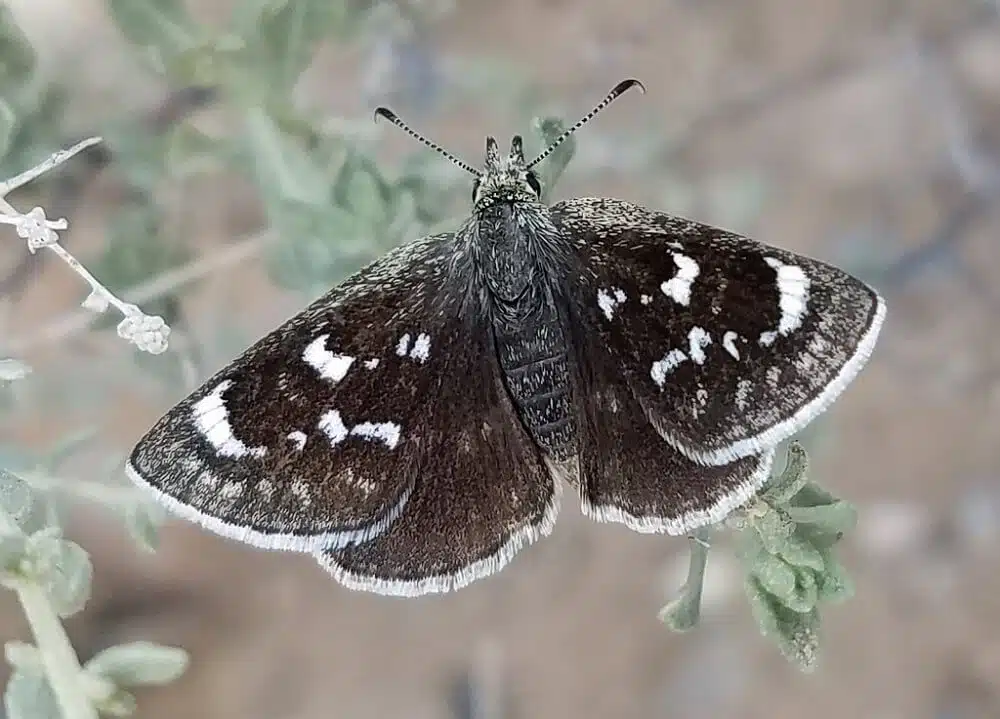
Desert sagebrush is among the multiple types of habitats the Mojave Sootywing (Hesperopsis libya) can inhabit.
This dark butterfly is dependent on the short bushes that still grow in the desert, such as chamiso.
Adults prefer to feed on the nectar of wildflowers here and are on wing for at least 2 generations per year.
Its caterpillars feed on the leaves of this host plant until pupating.
The Mojave Sootywing is dominated by dark brown nuances, mostly specific to its forewings.
Small white spots are specific to its forewings while its hindwings show a row of larger white or gray spots.
6. Agile Ground Mantis
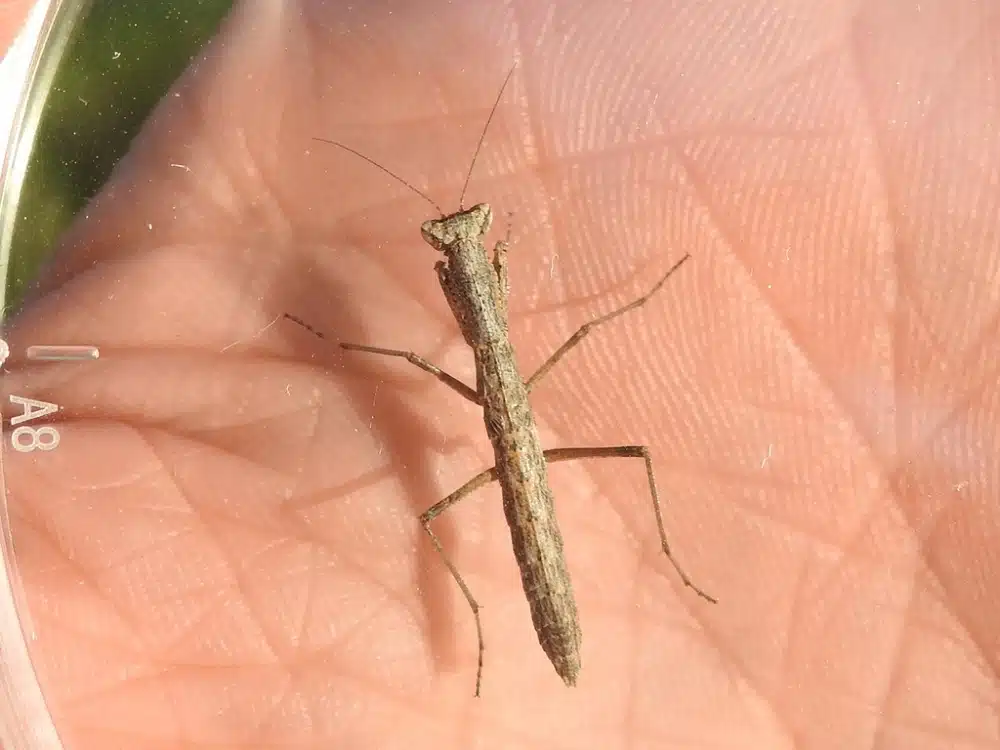
Agile Ground Mantises (Litaneutria minor) are some of the most aggressive little bugs of The Mojave Desert.
Seen in different colors, including brown, this is a type of predatory bug that often feeds on butterflies and moths, a common sight on the vegetation it lives on.
The aggressive behavior of the species is seen when it defends itself or when it looks for food.
That’s right, Agile Ground Mantises are actively looking for prey. These bugs don’t wait around and start chasing or intimidating prey by standing up, making them appear as tall as possible.
When it does decide to take a step back, this bug hides among rocks to take advantage of its dark camouflaging appearance.
7. Desert Recluse

Also brown but much more dangerous, The Desert Recluse (Loxosceles deserta) is a spider species adapted to living in the desert, often in the most arid locations of the desert.
Only growing up to 0.5 inches, this is a species that can bite and immobilize prey.
Its bite isn’t a good sign to humans either as it can cause skin necrosis.
To catch its next meal such as a butterfly, this type of spider builds a small web, typically in places that are confined.
This species may face an uncertain future as they’re often killed by humans, most likely due to being confused with the more dangerous Brown Recluse.
8. Doll’s Sphinx Moth

This type of moth (Sphinx dollii) is a rare sight in the desert, but still notably seen by those venturing out to these lands.
All spots where the moths are seen have at least several types of pine trees as the species relies on them for the growth of its caterpillar.
As it grows, the caterpillar of Doll’s Sphinx Moths takes on the appearance of their pine host by matching their green colors.
The adult moth itself is dominated by bright gray nuances with dark gray and black patterns across its hairy wings and body.
9. Victorville Shoulderband
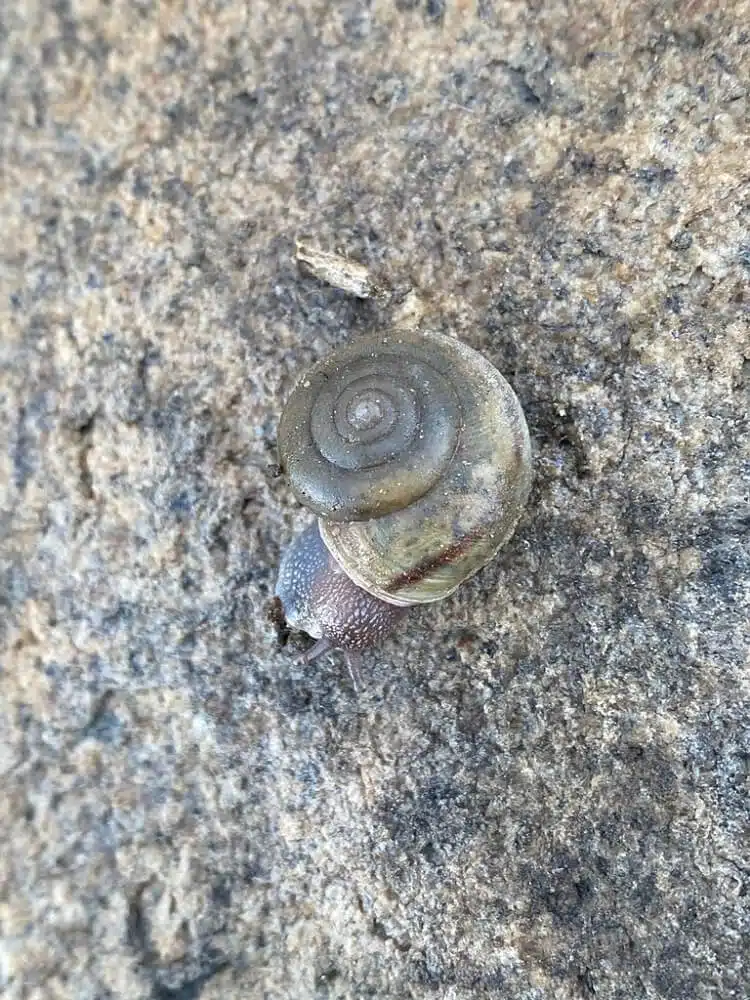
Another type of snail that remarkably survives in The Mojave Desert is The Victorville Shoulderband (Helminthoglypta mohaveana).
This is a species with a very limited habitat in the desert, on the other hand.
It only lives in a small area near Victorville, as its name implies.
Bright or dark and tan or brown, this is a species that darkens as it ages and that doesn’t expand its habitat, as most other types of land snails of The Mojave Desert.
Mammals in the Mojave Desert
10. American Desert Hare
American Desert Hares (Lepus californicus) are some of the largest hares in North America and have a considerable presence in The Mojave Desert.
This is a species that grows to a size of up to 2 feet and is known for its long ears.
Various shrub areas attract these hares for the food and shelter they offer in the desert.
A wider distribution is specific to The American Desert Hare, even outside the desert.
It also lives in chaparral and woodlands and is specific to the entire Southwestern US region.
The species does breed in warm areas and it can remain here looking for the spots with vegetation to feed on.
11. Botta’s Pocket Gopher

A species with a widespread distribution from California to Texas, Botta’s Pocket Gophers (Thomomys bottae) can live in diverse habitats.
Also found in The Mojave, the species is adaptable. One of the areas it may not match the life cycle of the gophers in other regions is breeding age.
Females take longer to begin breeding if they live in the desert.
Sometimes reaching a size of more than 10 inches, this gopher lives in burrows.
It’s better at digging burrows and its strong teeth help it build its nest underground, to escape the high heat during the day.
These gophers are generally active, spending up to half a day outside of their burrow, looking for food.
12. California Leaf-Nosed Bat

A preference towards caves and grottos is specific to bats in general, including California Leaf-Nosed Bats (Macrotus californicus).
This type of bat is abundant in The Mojave where it always seeks out refuge as a place to live in.
Unlike other bats, even the smaller retreats are sufficient for the bat to nest in.
This species of bats comes out for food and there’s plenty for it to have around the desert.
While it can chase different insects, The California Leaf-Nosed Bat is a common predator of moths in The Mojave.
As expected, the species is nocturnal, often preferring to chase these insects before sunrise.
13. Coyote

Coyotes (Canis latrans) are highly adaptable and one of the largest animals in The Mojave Desert.
One of the reasons the species manage to survive here is their ability to turn to plants in the absence of a carnivorous alternative.
These types of coyotes are, different, from coyotes outside of the desert.
A plant-based diet also means they are thinner and smaller than coyotes in other territories.
Still, they share some of their behavioral traits with coyotes of other regions. This includes living in packs and having specific vocalizations as a means of communication.
Coyotes are some of the few types of mammals in The Mojave, together with similarly-sized sheep.
14. Canyon Bat
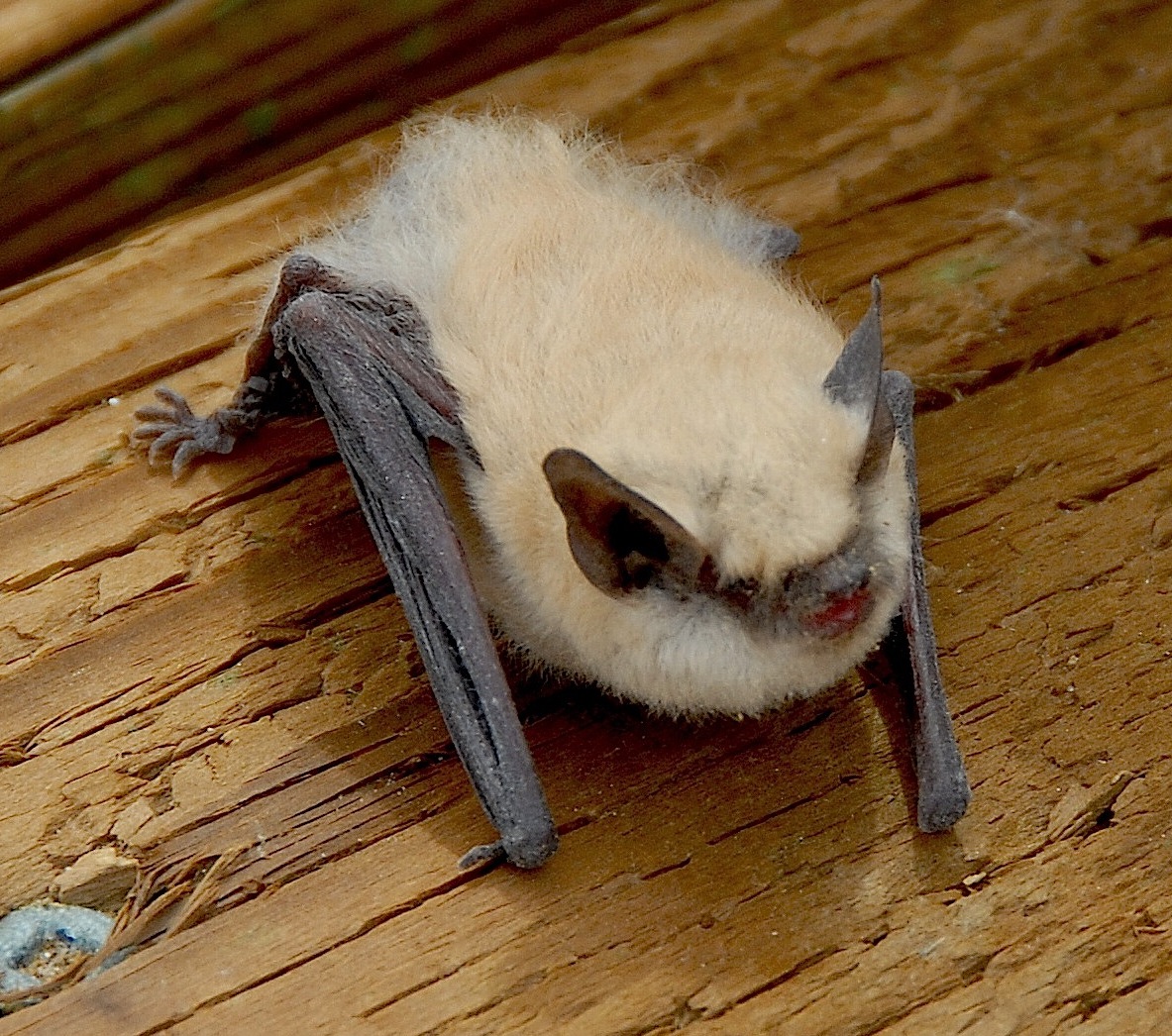
Almost white, this cream-ivory bat also lives in The Mojave Desert where it’s rarely brown.
This is a species adapted to catching prey in-flight and can do so even after sunrise, unlike other bats here that may only eat 1-2 hours before sunrise.
Most bats of The Mojave don’t look for food in the middle of the night, which is also the case for The Canyon Bat (Parastrellus hesperus).
This bat is active during the warmer months but may enter hibernation. Females who eat more may enter hibernation later or briefly.
Both males and females are adapted to living in the lowlands and they may inhabit old mines.
15. Desert Cottontail

A species of rabbits common in the Southwest and in The Mojave Desert, these rabbits (Sylvilagus audubonii) grow to 30 inches.
Some of their adaptations to the desert climate include living in burrows, mostly in the burrows of other species.
Since they only eat plants, Desert Cottontails survive a long time in this desert.
While they aren’t active at noon, they can be spotted eating grasses in the morning or later in the evening.
Plants make up the bulk of its diet but these rabbits can also chew their way through bark and other food sources.
This is a species that can become highly numerous after a long rainy season which triggers plenty of new plant growth.
16. Desert Kangaroo Rat

A species of dunes, The Desert Kangaroo Rat (Dipodomys deserti) is one of the common rodents of The Mojave Desert.
Feeding all the time, this is a type of rodent that is also aware of its surroundings and its potential nearby predators all the time.
Desert Kangaroo Rats are mostly prey to snakes and birds.
When they spot snakes, they may not run away and try to persuade them back instead.
This is a rodent that kicks sand in the direction of the snake. In turn, this startles the snake and makes it a lot less likely to bite.
Apart from kicking sand in the air, this rat also lives in burrows, away from the direct line of sight of most of its predators.
17. Kit Fox

Kit Foxes (Vulpes macrotis) are some of the smallest types of foxes in the world.
Despite their reduced size, they still live in difficult conditions such as those in the desert, preferably in dens.
These foxes survive the difficult desert conditions by eating opportunistically.
Rodents and insects are among their most common prey. Small Kit Foxes can raid the burrows of different rodents in the desert for food.
Gray, orange, or brown, Kit Foxes can live very long lives. In the desert, most survive only for a few years as they’re also prey for different types of prey such as coyotes and snakes.
18. Desert Woodrat

Desert Woodrats (Neotoma lepida) are some of the most aggressive rodents in the desert.
They eat all the time and they can even scare off other Desert Woodrats from food sources they scarcely find.
Unlike most other rodents of The Mojave Desert, The Desert Woodrat also builds a nest-like construction to hide in.
Using readily-available materials such as plants and dead wood, this nest is a multi-entrance construction.
It uses it to run away and hide from predators or as a location to spot food.
These pack rats rarely enter the homes of others of their species as they’re territorial and aggressively defended.
This is also a species that marks its territory similarly to dogs.
19. Mohave Ground Squirrel

Mohave mixed wood scrub is among the favorite habitats of The Mohave Ground Squirrel (Xerospermophilus mohavensis).
This small species is also adapted to other types of habitats such as Joshua tree habitats.
Living a life similar to any other rodent, this ground squirrel lives in areas where it can forage.
Outside of these areas, they are vulnerable. Even here, populations can be very low in prolonged drought.
These squirrels may be able to live longer than other species through hibernation.
20. Panamint Chipmunk
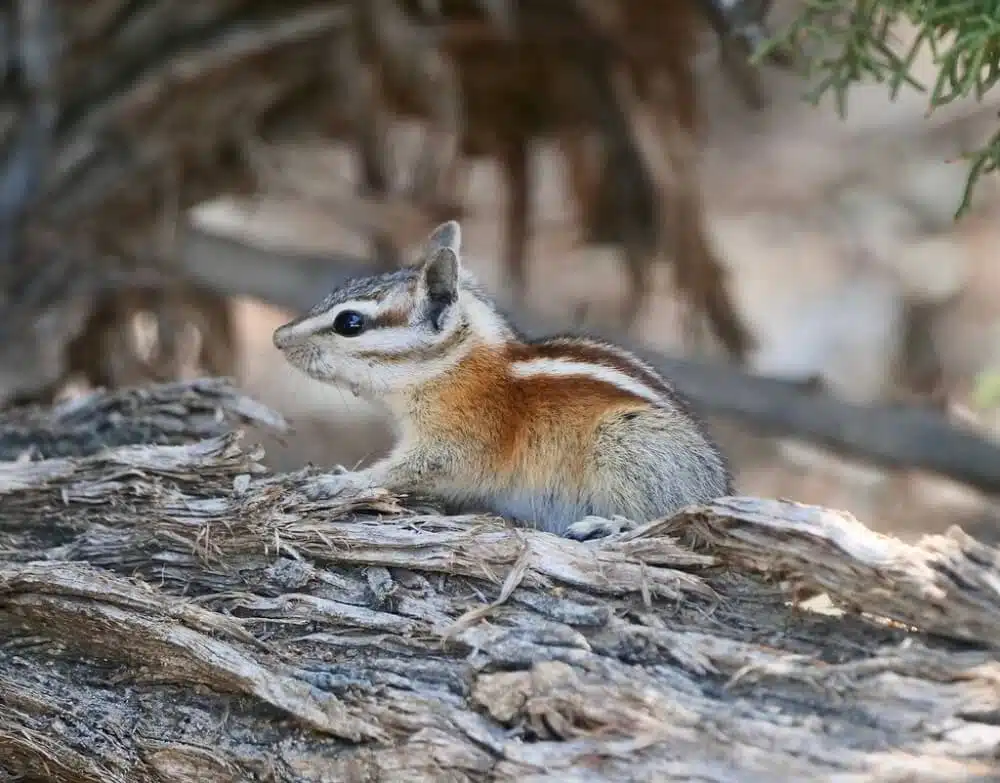
Common found around juniper, Panamint Chipmunks (Neotamias panamintinus) are among the ground species that change coat for the winter.
They have a brighter appearance in the summer and can be distinguished by their striped backs.
Gray and tan stripes are seen on the back and the top of the head of these species.
Brown stripes additionally feature gray spots along the back as well.
This species is found only around rock outcroppings in the desert. Small and often vulnerable, it’s one of the important prey for local birds.
It also provides a food source for other species as it uses a sysmte of food caches to stack its food.
21. Ringtail

A species with up to 16 stripes of black bands on its tail, Ringtails (Bassariscus astutus) are an important species of The Mojave ecosystem.
They are both prey and predators. Foxes like to eat ringtails.
In turn, ringtails are a common predator of frogs, snakes, and other ground-dwelling species such as squirrels.
This striped-tail species can also eat carrion, showing opportunistic feeding traits.
Some of the places in the desert where they can be spotted include trees and deadwood.
22. Round-Tailed Ground Squirrel

Round-Tailed Ground Squirrels (Xerospermophilus tereticaudus) are smaller than Ringtails.
They grow tails to a length of 4.4 inches while Ringtails can grow tails as long as 17 inches.
Plants and insects are the main types of food considered by Round-Tailed Ground Squirrels.
This is also a species that feeds on seeds.
Like many types of squirrels, the species can also climb for food.
These small squirrels are also common food for foxes and snakes.
Some of the few methods they use to defend themselves is to live in groups. This allows them to alert other members of their group when a predator enters their range.
23. Salinas Pocket Mouse
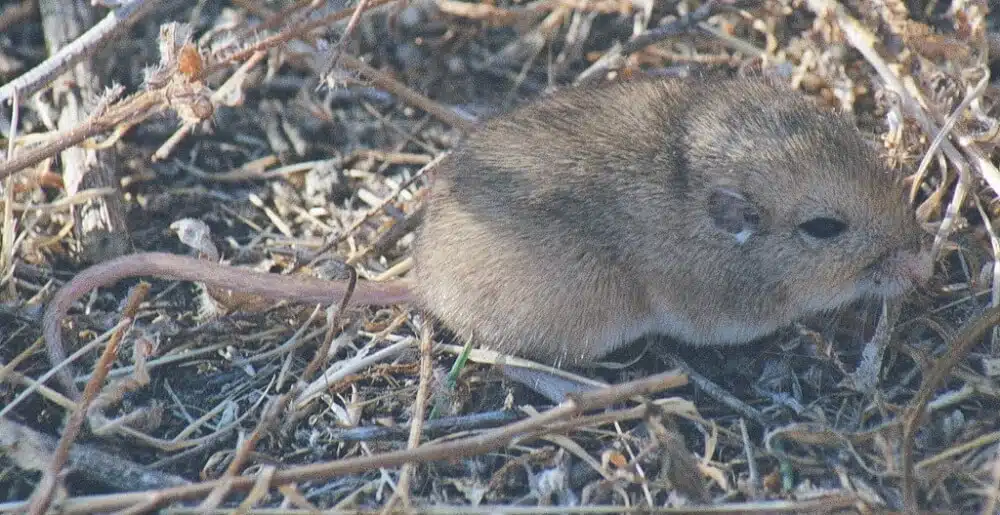
Salinas Pocket Mouse (Perognathus inornatus) is named after its atypical check pockets.
Used for food transportation, these are adaptations similar to those of The Kangaroo Mice of the Desert.
Their cheek pockets are used to store seeds and grasses which the rodents carry back to their nest to save for later use.
Salinas Pocket Mouse don’t immediately start eating the foods they store for later consumption.
They use this as a reserve to visit once high drought periods begin when food supplies may be scarce.
Reptiles and Amphibians in the Mojave Desert
24. Amargosa Toad

Draining in the desert, The Amargosa River is home to The Amargosa Toad (Anaxyrus nelsoni).
One of the rarest types of toads in The US, this is a species that only lives in a small habitat of a few square miles along this river, where there’s some type of vegetation.
Small and almost black, this frog shows a bright dorsal stripe and multiple small warts on its skin.
A reduction of habitat also means The Amargosa Toad is the next species to be eradicated from its desert habitat as it’s already present only in low numbers.
24. Desert Tortoise

Desert Tortoises (Gopherus agassizii) are one of the most enduring species of The Mojave Desert.
They have a long lifespan, a slow lifecycle, and the capacity to survive both hot and cold weather.
Digging their burrows, Desert Tortoises can inhabit them for almost their entire lives, which aren’t short.
In some cases, Desert Tortoises can even live longer than humans, with record-holding lifespans of up to 80 years.
While The Desert Tortoise relies on burrows to escape the high and low heat, they use multiple burrows, in rotation.
At least 5 burrows are used by the species each year or for a few years in a row.
26. Sidewinder

A species named after its movement patterns, Sidewinders (Crotalus cerastes) are among the typical venomous snakes of The Mojave.
This is a species with a highly dangerous bite, albeit less venomous than the bites of other rattlesnakes.
It takes up to 3 years for these snakes to reach breeding maturity, but the female gives birth to live young once they can.
Up to 10 live young are born each year from a bred female which lives around 5 years.
Males tend to live longer but most Sidewinders end up as prey for the many predators of the desert in the meantime.
27. Speckled Rattlesnake

Also known as The White Rattlesnake, The Speckled Rattlesnake (Crotalus mitchellii) is a venomous snake with a white ground color.
It represents a species with black specs on the dorsum and a snake with additional brown bands.
The species is found in The Mojave Desert in floodable areas as well as across sandy areas.
It also lives in other areas with vegetation and it generally shows a warning sign before biting.
This involves rattling its tail but biting humans isn’t high on its list of priorities.
Small mammals such as rodents are the primary target of their venomous bite.
28. Mojave Rattlesnake

The Mojave Rattlesnake (Crotalus scutulatus) is often considered the most venomous rattlesnake in the world.
Snakes of the species are known for their brown blotches with black borders and their highly venomous bite.
The potent venom of the species attacks the nervous system as well as the muscles and can easily kill humans.
Deaths are rare as the right medical attention right after the bite has a high success rate.
This species can live on its own or together with others, particularly during the winter-reduced activity period.
Snakes of the species live next to trees or scrubs, but also between local cacti.
29. Inyo Mountains Salamander

The Inyo Mountains Salamander (Batrachoseps campi) is an endangered species of California endemic to The Inyo Mountains.
An arid habitat is specific to these mountains but some remote springs still exist in the valleys, places these salamanders live.
Only reaching a size of 2-3 inches, Inyo Mountains Salamander are also not properly understood.
Apart from their endangered status, nobody knows exactly how they reproduce as their eggs are laid in water far from human activities.
As their name suggests, these are also salamanders that can live at higher elevations.
30. Desert Iguana
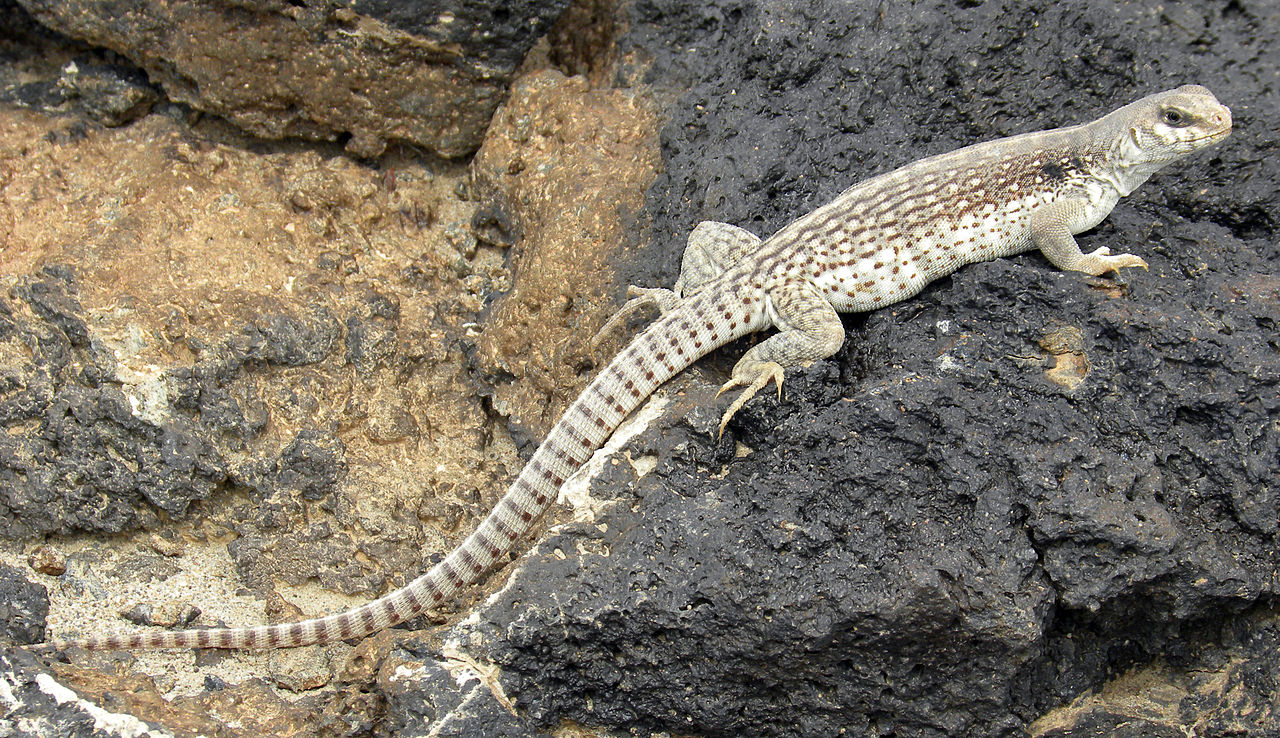
Only living in the desert, The Desert Iguana (Dipsosaurus dorsalis) grows to a size between 12 and 16 inches.
This species lives next to streams and creosote. bush as it mostly feeds on vegetation.
It survives the desert by going into burrows, but only in extreme temperatures.
Desert Iguanas often use the burrows of other species such as Kit foxes. They may also feed on ants and termites found in the ground.
When it digs its burrows, it gets to choose a perfect location such as under its favorite bush, the creosote bush.
This species can only live here in areas of high heat as the extra heat of the desert helps eggs hatch within days.
31. Desert Night Lizard

A species growing to 2.7 inches, The Desert Night Lizard (Xantusia vigilis) lives in burrows and crevices.
Its burrows are located close to bushes and other plant the lizard eats.
Desert Night Lizards can live individually or in small groups over a wider area, typically in the vicinity of yuccas.
A species that becomes widely inactive in the winter, The Desert Night Lizard is more likely to be seen in small groups during the cooler months.
Tens of lizards stick together in the cool months to benefit from their body heat and to survive the cooler periods of the year as a group.
32. Desert Rosy Boa

A species that feed on desert rodents, The Desert Rosy Boa (Lichanura trivirgata) is one of the colorful snakes of The Mojave Desert.
It hides in burrows both from extreme temperatures and from predators.
A diurnal species, The Desert Rosy Boa relies on the outdoor temperature to support its vital roles.
This is a species that bromates in the winter and that only becomes active once the weather is warm.
A docile species, The Desert Rosy Boa is a long-living species even in captivity where it can live for decades.
33. Mojave Fringe-Toed Lizard

A species of lizard with an appearance dominated by earth colors, Mojave Fring-Toed Lizards (Uma scoparia) are cream to tan with a black dorsal pattern.
Their appearance alone helps them camouflage themselves but these lizards also tend to retreat in cracks and burrows of threatened.
Their survival in the desert doesn’t depend on a single plant as they eat multiple plants, their seeds, and small insects.
While it doesn’t show cannibalistic traits, The Mojave Fringe-Toed Lizards also eat the young lizards of other species.
Males of the species tend to be the most aggressive and eat more small lizards of other species.
34. Common Chuckwalla

Native to The Mojave Desert, The Common Chuckwalla (Sauromalus ater) is one of the rare dark, almost black, lizards in the area.
Males are dominantly black while females are mostly brown.
The male Common Chuckwalla is also highly aggressive compared to females in periods of low food availability.
High aggression may only be specific to the larger males who dominate certain areas through their imposing size first.
As a large number of Mojave Desert species, The Common Chuckwalla is a species mostly found around creosote bushes.
They don’t exclusively eat plants as they can also eat the insects that visit these plants.
35. Western Banded Gecko

A yellow and red type of gecko, The Western Banded Gecko (Coleonyx variegatus) is a species that shares its habitat with The Common Chuckwalla.
Both species live around creosote bushes as well as in sagebrush areas of the desert.
This gecko is also found in other areas outside of the desert such as juniper woodlands.
Completely different in terms of appearance, The Western Banded Gecko is also a species that has atypical vocalizations.
Its chirp-like sounds are its defensive reactions to a potential threat as well as signals to other geckos of a nearby predator.
36. Zebra-Tailed Lizard

Some lizards have differently-colored tails. This is also the case with The Zebra-tailed Lizard (Callisaurus draconoides), a species with a black and white tail and a gray-brown body.
The tail looks similar to the contrasting colors of a zebra and it can be raised as a sign of communication of dominance.
These types of lizards are found in a variety of areas within the desert, typically close to water.
While it can live without water for a long time, this type of lizard depends on the species that live close to water such as mosquitoes it feeds on.
This lizard is also found in high numbers in the areas of the desert with creosote scrub, a type of flower plant that feeds wildlife.
Birds in the Mojave Desert
37. Bendire’s Thrasher

Growing to a size of up to 11 inches, the resilient Bendire’s Thrasher (Toxostoma bendirei) is a species that lives and nests on trees.
This bird lives on the highest point of the tree but builds its nests lower, to hide it from other birds.
Brown nuances are specific to its wings while its head and underbelly are dominated by gray nuances.
Bendire’s Thrashers eat insects. They can fly around trees, shrubs, and to the ground for insects such as ants.
Birds of the family are additionally known for having multiple types of vocalizations for different types of communication.
38. Cactus Wren

A common species in The Mojave Desert, Cactus Wren (Campylorhynchus brunneicapillus) are found in a widespread area from California to Arizona.
They are considered the largest birds among wrens and can reach a maximum size of 8 inches.
The name of the species is inspired by its tendency to live on cacti. This bird uses its downward-pointed bill to create nests right in cacti for extra protection.
This species feeds on cacti and insects but it’s normally associated with nectar from cacti as it spends much time around species such as saguaro cacti.
39. California Quail

This type of crested bird (Callipepla californica) is recognized as a state bird in California.
Its subspecies of Gambel’s Quail is found in desert regions where it survives on plants and insects.
A species mostly relying on the foods that can be found on the ground, these types of birds can fly but rarely fly.
They tend to live and breed in groups as well. Females lay a large number of white eggs with black spots and the emerged chicks tend to start life on their own quickly living the nest.
40. Costa’s Hummingbird

Costa’s Hummingbirds (Calypte costae) have a colorful appearance, complex breeding habits, and a short pointy beak it relies on to feed on nectar.
Males get a purple cap entering the breeding season while females are mostly dull brown.
The breeding habits of these birds are also distinct.
Males that change colors fly around females in a way in which they can exhibit their purple heads and necks the most.
The metallic purple nuance of the species shines in the sun and the male bird tries to showcase its distinct physical trait for higher breeding success.
41. Greater Roadrunner

The Mojave Desert is home to several walking birds, including the fast Greater Roadrunner (Geococcyx californianus).
A crested species, the Greater Roadrunner can achieve a size of 24 inches, but can also measure less than 20 inches as an adult.
Birds of the species have multiple vocalizations which are relied upon depending on the activity.
For example, males have morning-specific vocalizations just like roosters.
Both males and females have distinct vocalizations in the breeding period as well. As it measures more than 20 inches, the bird also has loud vocalizations audible from hundreds of feet away.
42. Lawrence’s Goldfinch

The small Lawrence’s Goldfinch (Spinus lawrencei) grows to a size of up to 4 inches and features multicolored plumage.
Its head is black while its body and wings show a combination of yellow, gray, and white colors.
Goldfinches of this species are only occasionally seen in The Mojave Desert. Some years, they are even absent from the areas.
These birds arrive in the desert outside of their nesting season and eat flowers, seeds, and the small fruits of the local plants.
Flocking is also specific to these birds as they move about in small groups and are never alone.
43. Plumbeous Vireo

Dominated by gray nuances, Plumbous Vireos (Vireo plumbeus) live in the trees of the desert.
These small birds feed on insects and also live in other areas outside of the desert, preferring forests.
The spring marks the peak activity period for the species, also a time when their vocalizations are likelier to be heard.
While it doesn’t live as long in The Mojave as in other areas, this species can still live up to 5 years in its habitat as a migrating bird.
44. Vermilion Flycatcher

The Vermilion Flycatcher (Pyrocephalus obscurus) is not the first species to come to mind when speaking about The Mojave Desert.
This bird is more common outside of the desert, in Central America, as well as in parts of Northern South America.
Known for its vivid red crest and plumage (mostly seen on males) this is a species that also flies into the desert.
Its love of insects means it sticks to the areas of the desert closest to the water.
45. Woodhouse’s Scrub Jay

A bird with multiple subspecies, Woodhouse’s Scrub Jay (Aphelocoma woodhouseii) is also present in The Mojave Desert.
Mostly blue and gray, this is also one of the longest-living birds in the desert.
If Plumbeous Vireos only live up to 5 years, The Woodhouse’s Scrub Jay lives up to 9 years.
This bird feeds on insects but also other wildlife such as small frogs and toads.
Fish of the Mojave Desert
46. Amargosa Pupfish

Like most species of Mojave fish, The Amargosa Pupfish (Cyprinodon nevadensis) is tied to The Amargosa River.
It lives in the lower parts of the river where it only survives up to 1 year or slightly more than 1 year.
The populations of this species are considered stable. Living in the protected area of The Amargosa Canyon, these fish eat algae.
47. Death Valley Pupfish

An endangered species, The Death Valley Pupfish (Cyprinodon salinus) is among the multiple species with a vulnerable future.
Introduced species are believed to have reduced their numbers considerably.
Reaching a size of up to 3.2 inches, The Death Valley Pupfish is a species that changes colors into the breeding season. Males turn dark blue for the breeding season.
48. Desert Sucker
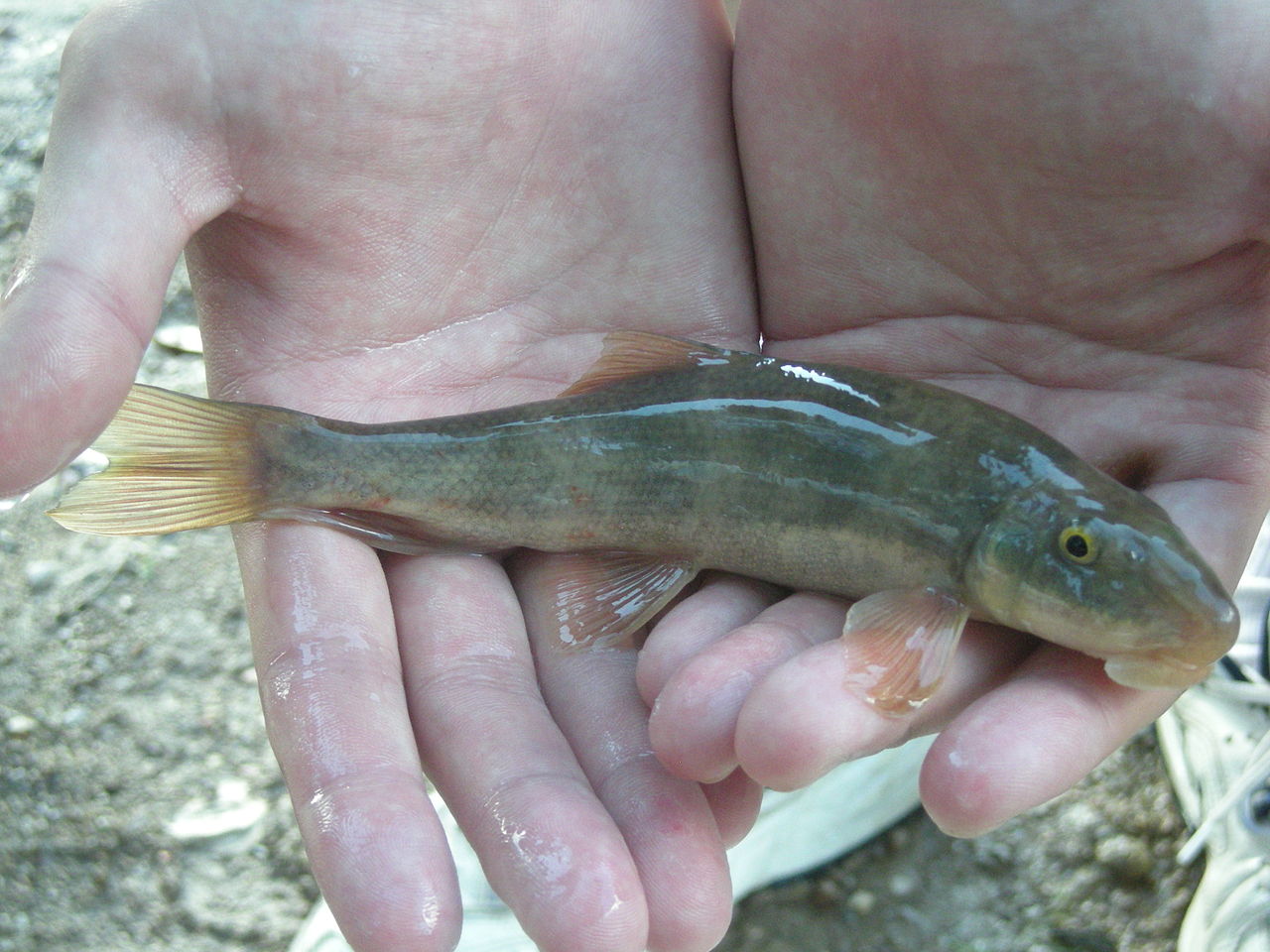
This type of olive fish is associated with rapid waters. Within these fast-moving waters, The Desert Sucker (Catostomus clarkii) is found in areas with gravel-rich bottoms.
Small within its first years, this fish is known to grow slowly.
Still, it can reach a length of over 30 inches. Most Desert Suckers in The Mojave are considerably smaller, on the other hand.
49. Devils Hole Pupfish

A species of shallow waters of the desert, The Devils Hole Pupfish (Cyprinodon diabolis) is one of the blue fish of The Mojave Desert.
As Death Valley Pupfish, the male Devils Hole Pupfish is also dark blue while the female is bright gray.
Associated with water in caverns, this still has some types of predators, especially in its early days as eggs.
Diving beetles are among the common predators of their young,
50. Tui Chub
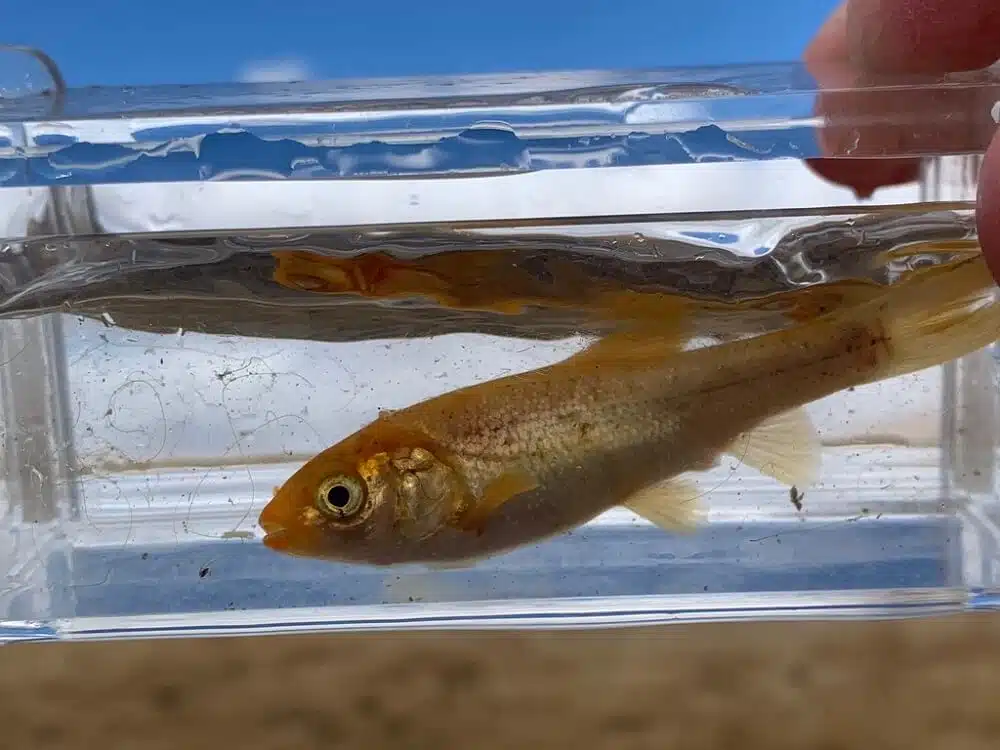
Only found in desert Streams, Tui Chub (Siphateles bicolor) is spread around The Mojave River.
This species can grow to 18 inches and can be one of the control agents of smaller fish in its area as its diet is based on fish.
While it eats algae, Tui Chub fish eat small fish as adults.
Fish of the species can be identified by their colors. Dark olive on the back, this fish is silver-gray on the sides and below.